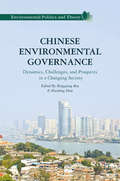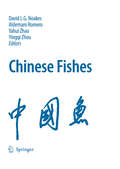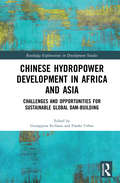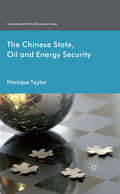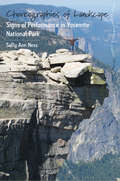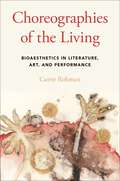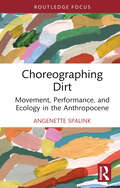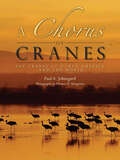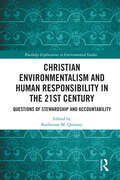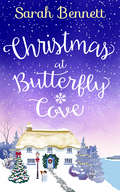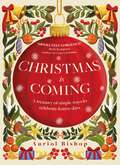- Table View
- List View
China's Way to Carbon Emissions Reduction: The Choice of Regulatory Instruments and Its Legal Challenges
by Ying ShenNow that the most recent scientific estimates have shown that China has become the world's largest source of greenhouse gas emissions, China's influence on the world's environment and sustainable development highlights the importance of tailoring Chinese climate change law to conform with the requirements of international conventions and agreements on climate change. This thorough analysis, based on an examination of climate status, legal background, and current regulatory systems in China, examines the potential role of different policy instruments in reducing carbon emissions in order to find an appropriate choice for China, and recommends approaches to key issues for relevant authorities. The author conducts a comprehensive and in-depth study on the three mainstream environmental policy instruments used to control carbon emissions – the cap-and-trade system, the carbon tax, and command-and- control regulations – in a Chinese context. She reviews China's current policies, and elucidates how the issues of climate change and global warming call for social, environmental, economic, and legal reforms in China, especially in the areas of administrative law and property rights law. Among the issues and topics covered are the following: - key issues on designing and implementing each of the three policy instruments; - the choice of regulatory instruments for carbon emissions reduction in a socialist market economy based on the discussion of market failure and government failure theories; - legal challenges from China's current administrative legislation and the definition of carbon emissions entitlements; - practical effect of China's climate change policy at the national, provincial, and local levels; - effectiveness of China's implementation of its international obligations; - lessons learned from schemes implemented in the United States and Australia; - comparison of China's seven regional pilot emissions trading scheme (ETS) programmes with the well-established EU ETS; - linkage between China's ETS and other ETSs from a global perspective; and - future direction of an emerging carbon market in China. The analysis assesses the critical costs and benefits of each approach in the context of selected case studies, taking legal literature in the field fully into account. Given that the Chinese government is taking steps to reduce emissions by altering energy production and usage and is signalling a willingness to make similar commitments in a multilateral treaty, it is very timely and important for lawmakers and scholars, within and outside China, to think about new and appropriate regulatory measures to respond to the crisis and plan for a sustainable future. This study provides not only a useful benchmark for both China and other countries in formulating initiatives on enhancing climate protection, but also details the global implications for governments and for international organizations concerned with the understanding between China and the rest of the world in the context of climate change mitigation.
Chinese Environmental Governance: Dynamics, Challenges, and Prospects in a Changing Society (Environmental Politics and Theory)
by Bingqiang RenIn this edited volume, leading environmental policy experts from China, USA, and Europe provide a contemporary view of Chinese environmental policy, analyzing current discussions among various actors and agencies. The book covers a wide range of topics including the gap between national policy goals and their local implementation, cultural and social factors shaping political behavior, legal and political systems affecting environmental policy creation and execution, new societal forces participating in environmental policymaking and governance, and local state strategies tasked with navigating a mix of political, legal, and societal forces. Featuring in-depth, empirically-grounded analyses with interdisciplinary approaches, the book is ideal reading for scholars interested in the complex nature of balancing Chinese environmental sustainability and economic growth.
Chinese Fishes (Developments in Environmental Biology of Fishes #28)
by Yahui Zhao Yingqi Zhou David L. G. Noakes Aldemaro RomeroThis book documents the current state of research by Chinese scientists on fish biology and fisheries and brings together manuscripts by authors from research institutions, universities and government agencies. There are papers on aquaculture, life history, genetics, marine and freshwater biology, conservation, physiology, new species descriptions, and truly amazing hypogean fishes. The information on these remarkable cave species shows how much we have yet to learn from that incredible fauna. There are papers dealing with some of the largest fishes and some of the smallest cave species. There are papers dealing with some of the most traditional forms of aquaculture and others with the most modern molecular techniques. The volume includes papers on critically threatened native fishes as well as the most common food species, such as grass carp (Ctenopharyngodon idella). The information on rare and threatened species shows how China is dealing with their endangered fishes. The information on their carp species will be invaluable to those in other countries who will either take advantage of the productive carp species in aquaculture or try to manage them as invasive species outside China. For the first time we bring together a complete overview of the state of fisheries research in China.
Chinese Hydropower Development in Africa and Asia: Challenges and Opportunities for Sustainable Global Dam-Building (Routledge Explorations in Development Studies)
by Giuseppina Siciliano Frauke UrbanIn recent years, both Chinese overseas investment and hydropower development have been topics of increasing interest and research, with Chinese actors acting as financiers, developers, builders and sub-contractors. Chinese Hydropower Development in Africa and Asia explores the governance and socio-economic implications of large Chinese dams’ development in low- and middle-income countries in Asia and Africa and asks how these big infrastructure projects promote sustainable local and national development in the recipient countries. The book first discusses general aspects of Chinese involvement in hydropower development in Africa and Asia, looking at political and economic aspects, before presenting selected case studies from large dams built and financed by Chinese actors in Asia and Africa. Based on these results, the book further makes recommendations on how to improve the planning, implementation and governance of large dams for sustainable global dam-building. This volume is a valuable resource for academics, researchers and scholars in the areas of Development, Environmental Studies, Politics and Economics.
Chinese Hydropower Development in Africa and Asia: Challenges and Opportunities for Sustainable Global Dam-Building (Routledge Explorations in Development Studies)
by Giuseppina Siciliano Frauke UrbanIn recent years, both Chinese overseas investment and hydropower development have been topics of increasing interest and research, with Chinese actors acting as financiers, developers, builders and sub-contractors. Chinese Hydropower Development in Africa and Asia explores the governance and socio-economic implications of large Chinese dams’ development in low- and middle-income countries in Asia and Africa and asks how these big infrastructure projects promote sustainable local and national development in the recipient countries. The book first discusses general aspects of Chinese involvement in hydropower development in Africa and Asia, looking at political and economic aspects, before presenting selected case studies from large dams built and financed by Chinese actors in Asia and Africa. Based on these results, the book further makes recommendations on how to improve the planning, implementation and governance of large dams for sustainable global dam-building. This volume is a valuable resource for academics, researchers and scholars in the areas of Development, Environmental Studies, Politics and Economics.
The Chinese State, Oil and Energy Security: Fuelling China's Rise (International Political Economy Series)
by M. TaylorMonique Taylor analyses the policy rationale and institutional underpinnings of China's state-led or neomercantilist oil strategy, and its development, set against the wider context of economic transformation as the country transitions from a centrally planned to market economy.
Chitin Chemistry
by George A.F. RobertsThe book presents a comprehensive and critical account of the chemistry of chitin and chitosan. The first three chapters cover chemical structure and morphology, including that of chitin-protein complexes of native chitin, the isolation of chitin and the preparation of chitosan, and methods of analysis for both polymers. The fourth and largest chapter deals with their derivatisation whilst further aspects of their chemistry such as acid-base properties, metal ion adsorption, degradation, solubility, solution behaviour and gelation, are dealt with in the final two chapters.
Chlorophyll Fluorescence: Understanding Crop Performance — Basics and Applications
by Mohamed H. Kalaji Vasilij N. Goltsev Krystyna Żuk-Gołaszewska Marek Zivcak Marian BresticChlorophyll a fluorescence is a tool for evaluating plant responses to stress conditions. Fluorescence can be used in plant phenotyping and breeding programs to monitor biotic and abiotic stresses including mineral deficiencies, soil salinity, and pathogenic diseases. Chlorophyll Fluorescence: Understanding Crop Performance — Basics and Applications reviews a diversity of instruments available for recording and analyzing different types of light signals from plants and addresses the use of chlorophyll a fluorescence in research on plants and other photosynthesizing organisms, such as algae and cyanobacteria. This book characterizes the phenomenon of chlorophyll a fluorescence, describes the methods for its measurement, and demonstrates — using selected examples — the applicability of these methods to research the response of the photosynthetic apparatus and plant tolerance to unfavorable environmental conditions. In addition, chapters cover a general background on photosynthesis, analysis of delayed fluorescence, and the pulse amplitude modulated (PAM) technique. The book is addressed to a wide range of professionals in photosynthesis research and scientists from other areas of plant sciences.
Chlorophyll Fluorescence: Understanding Crop Performance — Basics and Applications
by Mohamed H. Kalaji Vasilij N. Goltsev Krystyna Żuk-Gołaszewska Marek Zivcak Marian BresticChlorophyll a fluorescence is a tool for evaluating plant responses to stress conditions. Fluorescence can be used in plant phenotyping and breeding programs to monitor biotic and abiotic stresses including mineral deficiencies, soil salinity, and pathogenic diseases. Chlorophyll Fluorescence: Understanding Crop Performance — Basics and Applications reviews a diversity of instruments available for recording and analyzing different types of light signals from plants and addresses the use of chlorophyll a fluorescence in research on plants and other photosynthesizing organisms, such as algae and cyanobacteria. This book characterizes the phenomenon of chlorophyll a fluorescence, describes the methods for its measurement, and demonstrates — using selected examples — the applicability of these methods to research the response of the photosynthetic apparatus and plant tolerance to unfavorable environmental conditions. In addition, chapters cover a general background on photosynthesis, analysis of delayed fluorescence, and the pulse amplitude modulated (PAM) technique. The book is addressed to a wide range of professionals in photosynthesis research and scientists from other areas of plant sciences.
Choosing Our Future: A Practical Politics of the Environment (Routledge Revivals)
by Ann TaylorFirst Published in 1992, Choosing Our Future presents a personal but highly rigorous account of the environmental problems facing us and of the ways in which they can be tackled. Ann Taylor's approach centres on the traditional values of democratic socialism, establishing their inherent compatibility with modern concerns of sustainable economic development and environmental protection. She argues that people and planet are interdependent and that ensuring a balance between the needs of both is the historic role of the Labour Party. Lucid and topical, this book will appeal to anyone who is interested in realistic, hard- headed solutions to environmental problems. It will be of interest to general readers and to members of the Labour movement, environmentalists and professionals in environmental management and regulation. It will also be useful to students of politics and development.
Choosing Our Future: A Practical Politics of the Environment (Routledge Revivals)
by Ann TaylorFirst Published in 1992, Choosing Our Future presents a personal but highly rigorous account of the environmental problems facing us and of the ways in which they can be tackled. Ann Taylor's approach centres on the traditional values of democratic socialism, establishing their inherent compatibility with modern concerns of sustainable economic development and environmental protection. She argues that people and planet are interdependent and that ensuring a balance between the needs of both is the historic role of the Labour Party. Lucid and topical, this book will appeal to anyone who is interested in realistic, hard- headed solutions to environmental problems. It will be of interest to general readers and to members of the Labour movement, environmentalists and professionals in environmental management and regulation. It will also be useful to students of politics and development.
Choosing Safety: A Guide to Using Probabilistic Risk Assessment and Decision Analysis in Complex, High-Consequence Systems
by Michael V. FrankThe technological age has seen a range of catastrophic and preventable failures, often as a result of decisions that did not appropriately consider safety as a factor in design and engineering. Through more than a dozen practical examples from the author‘s experience in nuclear power, aerospace, and other potentially hazardous facilities, Choosing Safety is the first book to bring together probabilistic risk assessment and decision analysis using real case studies. For managers, project leaders, engineers, scientists, and interested students, Michael V. Frank focuses on methods for making logical decisions about complex engineered systems and products in which safety is a key factor in design - and where failure can cause great harm, injury, or death.
Choosing Safety: A Guide to Using Probabilistic Risk Assessment and Decision Analysis in Complex, High-Consequence Systems
by Michael V. FrankThe technological age has seen a range of catastrophic and preventable failures, often as a result of decisions that did not appropriately consider safety as a factor in design and engineering. Through more than a dozen practical examples from the author‘s experience in nuclear power, aerospace, and other potentially hazardous facilities, Choosing Safety is the first book to bring together probabilistic risk assessment and decision analysis using real case studies. For managers, project leaders, engineers, scientists, and interested students, Michael V. Frank focuses on methods for making logical decisions about complex engineered systems and products in which safety is a key factor in design - and where failure can cause great harm, injury, or death.
Choreographies of Landscape: Signs of Performance in Yosemite National Park (Dance and Performance Studies #8)
by Sally Ann NessAs an international ecotourism destination, Yosemite National Park welcomes millions of climbers, sightseers, and other visitors from around the world annually, all of whom are afforded dramatic experiences of the natural world. This original and cross-disciplinary book offers an ethnographic and performative study of Yosemite visitors in order to understand human connection with and within natural landscapes. By grounding a novel “eco-semiotic” analysis in the lived reality of parkgoers, it forges surprising connections, assembling a collective account that will be of interest to disciplines ranging from performance studies to cultural geography.
Choreographies of the Living: Bioaesthetics in Literature, Art, and Performance
by Carrie RohmanChoreographies of the Living explores the implications of shifting from viewing art as an exclusively human undertaking to recognizing it as an activity that all living creatures enact. Carrie Rohman reveals the aesthetic impulse itself to be profoundly trans-species, and in doing so she revises our received wisdom about the value and functions of artistic capacities. Countering the long history of aesthetic theory in the West--beginning with Plato and Aristotle, and moving up through the recent claims of "neuroaesthetics"--Rohman challenges the likening of aesthetic experience to an exclusively human form of judgment. Turning toward the animal in new frameworks for understanding aesthetic impulses, Rohman emphasizes a deep coincidence of humans' and animals' elaborations of fundamental life forces. Examining a range of literary, visual, dance, and performance works and processes by modernist and contemporary figures such as Isadora Duncan, D. H. Lawrence, Virginia Woolf, and Merce Cunningham, Rohman reconceives the aesthetic itself not as a distinction separating humans from other animals, but rather as a framework connecting embodied beings. Her view challenges our species to acknowledge the shared status of art-making, one of our most hallowed and formerly exceptional activities.
CHOREOGRAPHIES OF THE LIVING C: Bioaesthetics in Literature, Art, and Performance
by Carrie RohmanChoreographies of the Living explores the implications of shifting from viewing art as an exclusively human undertaking to recognizing it as an activity that all living creatures enact. Carrie Rohman reveals the aesthetic impulse itself to be profoundly trans-species, and in doing so she revises our received wisdom about the value and functions of artistic capacities. Countering the long history of aesthetic theory in the West--beginning with Plato and Aristotle, and moving up through the recent claims of "neuroaesthetics"--Rohman challenges the likening of aesthetic experience to an exclusively human form of judgment. Turning toward the animal in new frameworks for understanding aesthetic impulses, Rohman emphasizes a deep coincidence of humans' and animals' elaborations of fundamental life forces. Examining a range of literary, visual, dance, and performance works and processes by modernist and contemporary figures such as Isadora Duncan, D. H. Lawrence, Virginia Woolf, and Merce Cunningham, Rohman reconceives the aesthetic itself not as a distinction separating humans from other animals, but rather as a framework connecting embodied beings. Her view challenges our species to acknowledge the shared status of art-making, one of our most hallowed and formerly exceptional activities.
Choreographing Dirt: Movement, Performance, and Ecology in the Anthropocene (Routledge Studies in Theatre, Ecology, and Performance)
by Angenette SpalinkThis book is an innovative study that places performance and dance studies in conversation with ecology by exploring the significance of dirt in performance. Focusing on a range of 20th- and 21st-century performances that include modern dance, dance-theatre, Butoh, and everyday life, this book demonstrates how the choreography of dirt makes biological, geographical, and cultural meaning, what the author terms "biogeocultography". Whether it’s the Foundling Father digging into the earth’s strata in Suzan-Lori Park’s The America Play (1994), peat hurling through the air in Pina Bausch’s The Rite of Spring (1975), dancers frantically shovelling out fistfuls of dirt in Eveoke Dance Theatre’s Las Mariposas (2010), or Butoh performers dancing with fungi in Iván-Daniel Espinosa’s Messengers Divinos (2018), each example shows how the incorporation of dirt can reveal micro-level interactions between species – like the interplay between microscopic skin bacteria and soil protozoa – and macro-level interactions – like the transformation of peat to a greenhouse gas. By demonstrating the stakes of moving dirt, this book posits that performance can operate as a space to grapple with the multifaceted ecological dilemmas of the Anthropocene. This book will be of broad interest to both practitioners and researchers in theatre, performance studies, dance, ecocriticism, and the environmental humanities.
Choreographing Dirt: Movement, Performance, and Ecology in the Anthropocene (Routledge Studies in Theatre, Ecology, and Performance)
by Angenette SpalinkThis book is an innovative study that places performance and dance studies in conversation with ecology by exploring the significance of dirt in performance. Focusing on a range of 20th- and 21st-century performances that include modern dance, dance-theatre, Butoh, and everyday life, this book demonstrates how the choreography of dirt makes biological, geographical, and cultural meaning, what the author terms "biogeocultography". Whether it’s the Foundling Father digging into the earth’s strata in Suzan-Lori Park’s The America Play (1994), peat hurling through the air in Pina Bausch’s The Rite of Spring (1975), dancers frantically shovelling out fistfuls of dirt in Eveoke Dance Theatre’s Las Mariposas (2010), or Butoh performers dancing with fungi in Iván-Daniel Espinosa’s Messengers Divinos (2018), each example shows how the incorporation of dirt can reveal micro-level interactions between species – like the interplay between microscopic skin bacteria and soil protozoa – and macro-level interactions – like the transformation of peat to a greenhouse gas. By demonstrating the stakes of moving dirt, this book posits that performance can operate as a space to grapple with the multifaceted ecological dilemmas of the Anthropocene. This book will be of broad interest to both practitioners and researchers in theatre, performance studies, dance, ecocriticism, and the environmental humanities.
A Chorus of Cranes: The Cranes of North America and the World
by Paul A. Johnsgard“Since long before medieval times cranes have been considered messengers of the gods, calling annually from on high to remind humans below of the passing years and of their own mortality. Now it is up to humans to take responsibility for controlling our own fate—and also to cry out to protect not only cranes but all the other wonderful creatures that share our increasingly fragile and threatened planetary ecosystem with us." —Paul A. Johnsgard, from the acknowledgments Accompanied by the stunning photography of Thomas D. Mangelsen, A Chorus of Cranes details the natural history, biology, and conservation issues surrounding the abundant sandhill crane and the endangered whooping crane in North America. Author Paul A. Johnsgard, one of the leading authorities on cranes and crane biology, describes the fascinating social behaviors, beautiful natural habitats, and grueling seasonal migrations that have stirred the hearts of people as far back as medieval times and garnered the crane a place in folklore and mythology across continents. Johnsgard has substantially updated and significantly expanded his 1991 work Crane Music, incorporating new information on the biology and status of these two North American cranes and providing abbreviated summaries on the other thirteen crane species of the world. The stories of these birds and their contrasting fates provide an instructive and moving history of bird conservation in North America. A Chorus of Cranes is a gorgeous and invaluable resource for crane enthusiasts, birders, natural historians, and conservationists alike. The University Press of Colorado gratefully acknowledges the generous support of the Iain Nicholson Audubon Center at Rowe Sanctuary, Audubon Nebraska, Ron and Judy Parks, Wagon Tongue Creek Farm, and the Trull Foundation toward the publication of this book.
The Christian Consumer: Living Faithfully in a Fragile World
by Laura M. HartmanBe it fair trade coffee or foreign oil, our choices as consumers affect the well-being of humans around the globe, not to mention the natural world and of course ourselves. Consumption is a serious ethical issue, and Christian writers throughout history have weighed in, discussing topics such as affluence and poverty, greed and gluttony, and proper stewardship of resources. These voices are often at odds, however. In this book, Laura M. Hartman formulates a coherent Christian ethic of consumption, imposing order on the debate by dividing it into four imperatives: Christians are to consume in ways that avoid sin, embrace creation, love one's neighbor, and envision the future. An adequate ethics of consumption, she argues, must include all four considerations as tools for discernment, even when they seem to contradict one another. The book includes discussions of Christian practices such as fasting, gratitude, solidarity, gift-giving, Sabbath-keeping, and the Eucharist. Using exemplars from the Christian tradition and practical examples from everyday life, The Christian Consumer offers a thoughtful guide to ethical consumption.
The Christian Consumer: Living Faithfully in a Fragile World
by Laura M. HartmanBe it fair trade coffee or foreign oil, our choices as consumers affect the well-being of humans around the globe, not to mention the natural world and of course ourselves. Consumption is a serious ethical issue, and Christian writers throughout history have weighed in, discussing topics such as affluence and poverty, greed and gluttony, and proper stewardship of resources. These voices are often at odds, however. In this book, Laura M. Hartman formulates a coherent Christian ethic of consumption, imposing order on the debate by dividing it into four imperatives: Christians are to consume in ways that avoid sin, embrace creation, love one's neighbor, and envision the future. An adequate ethics of consumption, she argues, must include all four considerations as tools for discernment, even when they seem to contradict one another. The book includes discussions of Christian practices such as fasting, gratitude, solidarity, gift-giving, Sabbath-keeping, and the Eucharist. Using exemplars from the Christian tradition and practical examples from everyday life, The Christian Consumer offers a thoughtful guide to ethical consumption.
Christian Environmentalism and Human Responsibility in the 21st Century: Questions of Stewardship and Accountability (Routledge Explorations in Environmental Studies)
by Katherine M. QuinseyChristian Environmentalism and Human Responsibility in the 21st Century comprises original scholarly essays and creative works exploring the implications of Christian environmentalism through literary and cultural criticism and creative reflection. The volume draws on a flourishing recent body of Christian ecocriticism and environmental activity, incorporating both practical ethics and environmental spirituality, but with particular emphasis on the notion of human responsibility. It discusses responsibility in its dual sense, as both the recognized cause of environmental destruction and the ethical imperative of accountability to the nonhuman environment. The book crosses boundaries between traditional scholarly and creative reflection through a global range of topics: African oral tradition, Ohio artists off the grid, immigrant self-metaphors of land and sea, iconic writers from Milton to O’Connor to Atwood, and Indigenous Canadian models for listening to the nonhuman Mother of us all. In its incorporation of academic and creative pieces from scholars and creative artists across North America, this volume shows how environmental work of its nature and necessity crosses traditional academic and community boundaries. In both form and orientation, this collection speaks to the most urgent intellectual, physical, social, and spiritual needs of the present day. This book will appeal to scholars, researchers, and upper-level students interested in the relationship between religion and environment, ethics, animal welfare, poetry, memoir, and post-secularism.
Christian Environmentalism and Human Responsibility in the 21st Century: Questions of Stewardship and Accountability (Routledge Explorations in Environmental Studies)
by Katherine M. QuinseyChristian Environmentalism and Human Responsibility in the 21st Century comprises original scholarly essays and creative works exploring the implications of Christian environmentalism through literary and cultural criticism and creative reflection. The volume draws on a flourishing recent body of Christian ecocriticism and environmental activity, incorporating both practical ethics and environmental spirituality, but with particular emphasis on the notion of human responsibility. It discusses responsibility in its dual sense, as both the recognized cause of environmental destruction and the ethical imperative of accountability to the nonhuman environment. The book crosses boundaries between traditional scholarly and creative reflection through a global range of topics: African oral tradition, Ohio artists off the grid, immigrant self-metaphors of land and sea, iconic writers from Milton to O’Connor to Atwood, and Indigenous Canadian models for listening to the nonhuman Mother of us all. In its incorporation of academic and creative pieces from scholars and creative artists across North America, this volume shows how environmental work of its nature and necessity crosses traditional academic and community boundaries. In both form and orientation, this collection speaks to the most urgent intellectual, physical, social, and spiritual needs of the present day. This book will appeal to scholars, researchers, and upper-level students interested in the relationship between religion and environment, ethics, animal welfare, poetry, memoir, and post-secularism.
Christmas at Butterfly Cove (Butterfly Cove #3)
by Sarah BennettA perfect Christmas read!’ Jessica’s Book Biz All she wants for Christmas…
Christmas is Coming: A treasury of simple ways to celebrate festive days
by Auriol BishopEvery page holds a treat to unwrap in this gorgeous advent calendar of a book.From Equinox to Solstice, Diwali to Epiphany - countdown to Christmas with poems, inspirations and little moments of comfort and joy.Dip into the pages of this little treasury and you'll find plenty to inspire you: from the festivals that sprinkle the days of October and November, to a daily delight for Advent and the Twelve Days of Christmas. Full of traditions, poems, stories and ideas for things to make and do, it's a celebration of all that we share across time, cultures and continents. A beautifully wise and calm companion to your festive season. Perhaps you'll have a go at making sloe gin when the berries are ripe in the hedgerows, or make popcorn on Walt Disney's birthday, or settle down with a hot chocolate to read 'Twas the Night Before Christmas. You might be tempted to peel a satsuma whilst discovering a little bit more about this festive fruit, or learn how many cultures hold ancient festivals of light. Or you might decide to simply take a moment to pause and enjoy a little page of peace in the whirl of counting down the sleeps. Let Auriol Bishop guide you through this most magical time of year . . .

